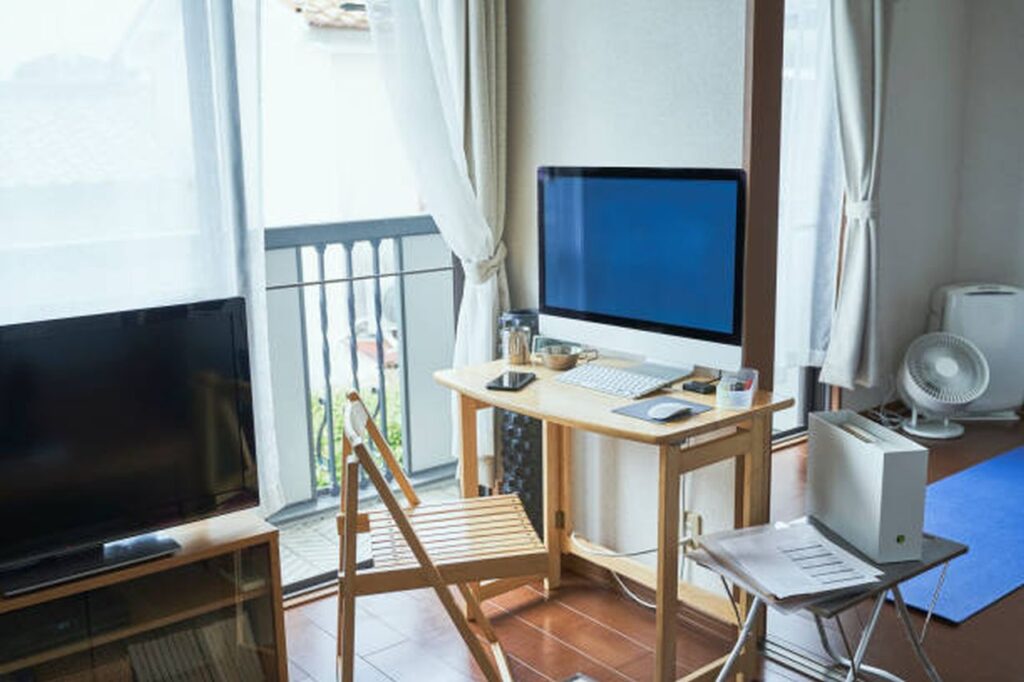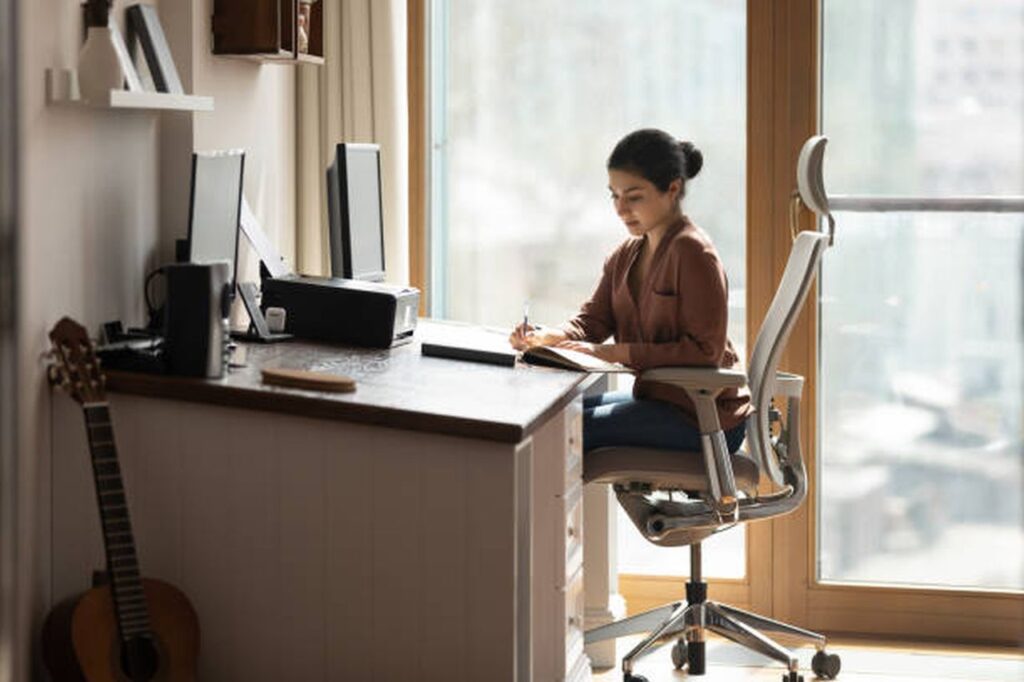The modern office of the remote worker or flexible employee is not a cubicle or even a floor-to-window corner office, and it’s wherever they happen to be working that day. Many hybrid employees alternate between working remotely and working from an office. They are often moving and carry the essentials between a home office, a coworking space, and anywhere.
In a post-COVID-19 world, more global employees work from anywhere. Gone are the days of rigid daily commuting and required on-site working. With the help of virtual communication and remote collaboration tools, the future of work is flexible and growing increasingly more so with every passing day. However, one fact about the state of modern work remains the same: it’s important to have a dedicated space where you can concentrate, work efficiently, and be creative without distractions. So, we’ve compiled a list of unique office spaces for anyone, as you work from anywhere.
Home Office Under The Stairs
Set yourself up beneath a staircase to create an efficient home office using a small amount of space (think Harry Potter origin story but chic and with way more natural light). This innovative setup incorporates a storage area, desk and workspace, and even plants if surrounding yourself with a little green is the secret ingredient in your productivity stew. By adding built-in shelves and a small desk chair, this creative area includes everything needed to work from home in about 18 square feet of space.
For Today’s Executive
The population of executives working from home is growing. Home offices can reflect the prestige and exude leadership when done correctly, providing a stately backdrop for video conferencing calls and meetings. In addition, the home office subtly incorporates ample storage in hidden cabinets and shelving.
Couple Coworking Status
Couples and roommates who share a workspace stay! If you and your living partner embrace the work from anywhere lifestyle, you may want to take advantage of the opportunity to turn some spare space in your home into a personalised coworking space. This shared workspace at home is just like a coworking space, but instead of sharing space with like-minded strangers, you are sharing space with your like-minded roomie. As a result, both individuals can focus and stay organised with clearly defined areas while maintaining a remote work-life balance.
Customised Coworking
Speaking of coworking space, some days, when you are working from anywhere, you may choose to work from a coworking or flexible workspace. Your coworking workspace may look like a few things depending on your membership plan. If your membership provides you with a dedicated desk or private office, don’t hesitate to spruce up your space with some greenery or your favourite inspirational art pieces. On the other hand, if you’ll be sitting at a different desk each time you visit, there’s still no need to sacrifice what makes your workspace unique. Bring a framed photo or two to prop up next to your laptop for some extra personalization.
Giant Wall Calendar For Visual Learners
Visual learners are more likely to work from anywhere for increased productivity and better focus. So what better way to enhance productivity than to utilise a flexible work schedule that lets you be creative no matter where you set up shop for the day? If you are a visual learner, try hanging a giant wall calendar up in your remote office to jumpstart each day with a sense of renewed purpose.
Hideaway Office For The True Minimalist
For the minimalist (or space-conscious) digital nomad, try a hideaway desk that allows you to quickly jump from work mode to home mode in no time at all. When can you be in or out of the office with the closing of a cabinet? Who knows what you will be freed up to accomplish? In addition, this convenient desk area will never gather clutter and help you make video calls or be productive in a distraction-free environment.
Chalkboard Walls For Creative Remote Workers
Putting up chalkboard walls is as easy as applying a new coat of paint. If you’ve got yourself a blank wall just waiting to be repurposed into a multi-functioning backdrop for your next virtual meeting, try decking out a space in your home with chalkboard paint. Your chalkboard wall can double as a wall calendar, to-do list, or creative outlet.
The Outdoor Office
You can set up your remote workspace outdoors for those lucky enough to live in temperate environments. When setting up your outdoor office like this creative, floral space, make sure you have WiFi that extends outdoors or a router that can stretch your signal. Once you have secured your WiFi connection, all you need to enjoy your outdoor office is a pair of sunglasses and a layer of SPF.
The Mobile Office For The Digital Nomad
Today’s work from anywhere culture allows for creative solutions for those who want to live on the move. So hitch this mobile office right onto your method of transportation, and you’ll have dedicated office space anywhere you want. Because when you can work from anywhere, why not work from everywhere?

A Standing Desk Setup
What is more indicative of the movement from anywhere than a desk you can work at from any position? It’s no secret that standing desks keep you more alert while working, and this alternative to sitting all day is an easy way to keep your health on track. The world is your office with a portable standing desk at your fingertips.
A Dedicated Space
Ideally, you would use a small room that can hold a desk and computer equipment and whose door can be shut for the essential need to separate work life from home life.
Most people don’t have spare space, but many people can convert a guest room into a dual-purpose space: an office most of the time and a guest room when people visit. (A Murphy bed is a great way to do that if your space and budget allow.) An enclosed porch, a large laundry room (or, for Europeans, a drying room), or even a garden shed can also do the double-duty trick.
If you can’t get a dedicated space, you can separate from the rest of your life. Try to find a niche space you can use that is out of the rest of the household’s way — and they are out of yours — as much as possible.
Proper Work Height
Your space needs a desk or table that is at work height. The industry standard is 29 inches from the floor to the top of the work surface. Tall people do better with a higher height, and short people do better with a lower height. Many desks and tables have adjustable height, usually through their feet.
But that industry standard is based on writing on paper, not using a keyboard and mouse. Keyboard trays pull out from below the work surface and are typically two inches lower than the desk or table height. Get one if you have space for a keyboard-and-mouse tray (it must be wide enough for both!). If not, consider lowering your desk to the tray height; if you also write on paper, you can get a writing surface (such as a thin cutting board) for pen-and-paper work.
You know your work surface is at the correct height if, when you sit up straight, your forearms are parallel to the ground, and your wrist is not bent up or down when you type or mouse. The top surface of your wrist should essentially be on the same plane as the top of your forearm, with your fingers dangling slightly down to the keyboard. Bending the wrists for prolonged periods is an easy way to cause injury.
Proper Monitor Height
Get a large monitor (maybe two) for your home office — just as you would at the corporate office. I’ve had good luck with 25- to 27-inch monitors from Asus and Acer, but any major brand will offer high-quality monitors. Avoid the cheapest monitors if you can, since they can lead to eyestrain over prolonged use due to their lower resolution and thus increased fuzziness.
Display resolutions come in a whole alphabet soup of terms but look for any of the following to achieve higher sharpness: QWXGA, QHD, WQHD, or 4K UHD. Also, note that the display connector may limit the screen resolution; on many computers, the video subsystem limits HDMI 1. x resolution to 1920 x 1200 pixels regardless of monitor size, making screens on 25-inch or larger monitors appear a bit fuzzy.
Generally speaking, check your computer’s video specs and get a monitor whose display resolution matches its maximum capability. You want computers and monitors that support HDMI 2. x, DisplayPort, or USB-C connectors for the best video quality. Because you likely already have a computer, such as a work-issued laptop, focus on getting a monitor whose specs meet or exceed what your computer can deliver.
Your monitor should line up so that if you look straight ahead when sitting straight, your eyes are at the height of 25% to 30% below the top of the screen. As a result, you keep your shoulders level and don’t hunch your back — two easy ways to cause injury.
You’ll likely need a riser for the monitor — I use two, which also gives me some handy shelving. A monitor whose height is adjustable is a plus, though you may still need a riser.
Tip: Be sure to measure the desired height of the monitor from the work surface so you know how much of a rise you need between the work surface and the monitor stand to get to that “top is 25% to 30% above eye level” target.
A Good Chair
There are a lot of bad chairs out there that can injure you over prolonged computer use. Dining chairs and deck chairs, for example, rarely are at the right height, and they don’t always encourage the needed upright posture.
If you can afford it, get an adjustable professional office chair like an Aeron, where you can set a precise fit for your body and workspace. But those typically go for $600 and up; there are also much cheaper office chairs — between $150 and $250 — that will do the job. You’ll need to test them out in person if at all possible since you can’t tell fit from a picture on a website.
Get one with adjustable height that can roll, provides lumbar support for the lower back, and ideally has adjustable seat pan tilt, arm height, and lateral arm position. An armrest is preferable, but only if you use it correctly: Your forearm should rest very lightly on the armrest; there should be no pressure from your arm onto the armrest. In addition, the armrest should remind your arm to stay in the right position, not support its weight like a seat does your butt.
Good Lighting
It’s very easy to underestimate the effects of your work environment on your ability to work. Lighting is often an area people don’t think about. Ideally, you have sufficient indirect light to illuminate your workspace, so you can easily read papers and see physical objects. Overhead lighting is usually best, such as from a ceiling lamp.
Indirect lighting means lights, not in your direct field of view or reflecting off your monitor. For example, an outside window behind or to the side of your desk can create glare on your monitor screen when the sun is shining. Natural light is quite pleasant, but diffuse it with shades or curtains, which doesn’t create glare.
Don’t place a lamp right next to a monitor, where you end up with competing light sources and possible glare. You may need lamps for additional lighting, but if possible, place them so that they don’t create glare on the monitor screen and are not in your direct field of vision when you’re working on the computer.
Likewise, make sure your monitor’s brightness is not too dim or too bright, which can cause eyestrain. “Too dim” and “too bright” are subjective. Still, a good rule of thumb is that the monitor’s lighting intensity should be just a little brighter than your ambient lighting and that ambient lighting should be sufficient to read paper documents without additional light.

Good Internet Service
Most urban and suburban areas have at least one high-speed provider for internet service; 50Mbps is the minimum speed to shoot for, and the more people using the internet at the same time, the more you want to get a higher-speed service.
The bandwidth within your home matters too. The best connections are wired Ethernet ones. Connect your computer to your router via an Ethernet cable; that’s especially important if you do video or other bandwidth-intensive work. WiFi is fine for basic office work, so use WiFi if you can’t wire your computer to your router.
In both cases, be sure to have modern equipment supporting at least 100Mbps for wired connections (1Gbps has been common for years) and at least 802.11n for wireless ones (802.11ac is much preferred). Almost every router with WiFi is dual-band, supporting newer standards like 802.11ac and 802.11ax (WiFi 6) and older ones like 802.11b/g/n that some of your devices may still use (such as older phones and some home-automation devices).
Headphones
In noisy environments, wearing headphones creates a more positive audio experience. Your choice of headphones will vary depending on your workspace. For example, if you’re using a dedicated microphone, you may prefer comfortable studio-style headphones without an in-line mic. On the other hand, if you want to reduce the amount of hardware you’re using, headphones with an in-line mic will be more appropriate.
Bluetooth headphones can be problematic for roles requiring a significant number of calls due to microphone quality, latency, and battery life limitations. If you opt for Bluetooth headphones, you may also want to use a separate wired microphone. In addition, Bluetooth headphones, if paired with multiple devices (e.g. one pair of headphones with a pairing history involving a laptop as well as a phone), may jump between devices. Therefore, we recommend pairing one Bluetooth headphone per device to avoid unexpected disconnects during video calls.
Conclusion
So, you’ve decided to take the plunge and start working from home. Congratulations! Now comes the hard part: setting up your new office space. It can be tricky to create a productive work environment when you’re used to being surrounded by distractions in your own home. But with a little bit of planning and some handy tips. We’ll walk you through everything you need to know about setting up your perfect home office for remote work. First, let’s talk about what type of workspace will best suit your needs.
Faqs
What Is Remote Work Set Up?
Remote work is a working style that allows professionals to work outside of a traditional office environment. It is based on the concept that work does not need to be done in a specific place to be executed successfully.
Where Should A Desk Be Placed In A Home Office?
Place your desk as close to a natural light source as possible. It would help to place your desk as close to a natural light source as possible. For example, some like to face the window but put the desk perpendicular to it if that proves too distracting.
Can I Expense My Home Office?
Instead of keeping records of all of your expenses, you can deduct $5 per square foot of your home office, up to 300 square feet, for a maximum of $1,500. As long as your home office qualifies, you can take this tax break without having to keep records of the specific expenses.
What Is The Most Efficient Desk Setup?
An adjustable standing desk is one of the most productive desk setup options. Besides that, you can also perform some easy exercises at your standing desk when taking a short break. It will give you many benefits which you may not know.
Should Your Desk Face The Window?
Windows are best on your side. If you’re facing the view, you’ll be distracted. Work while you’re at your desk and enjoy the view when you take a break.

